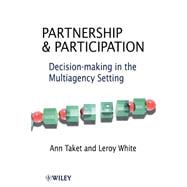
What is included with this book?
Ann Taket, Professor of Primary Health Care, Faculty of Health & Social Sciences, South Bank University, London. Has over 18 years experience in OR and Health Services Researchand has over 100 publications. She has worked as advisor to WHO, ODA and the British Council.
Leroy White, Principal Lecturer in Primary & Community Care Reearch, Faculty of Health & Social Sciences, South Bank University, London. Has over 10 years experience in OR in both the UK and developing countries. He has over 30 publications.
Leroy White & Ann Taket contributed 'Critiquing Multimethodology as Metamethodology: Working Towards Pragmatic Pluralism' to the Wiley book 'Multimethodology', edited by John Mingers and Tony Gill.
| Acknowledgements | xi | ||||
| Preface | xiii | ||||
| Part I Multiagency working | 1 | (64) | |||
|
3 | (16) | |||
|
3 | (1) | |||
|
3 | (4) | |||
|
7 | (3) | |||
|
10 | (2) | |||
|
12 | (1) | |||
|
13 | (1) | |||
|
14 | (5) | |||
|
19 | (20) | |||
|
19 | (2) | |||
|
21 | (1) | |||
|
21 | (1) | |||
|
21 | (2) | |||
|
23 | (1) | |||
|
24 | (1) | |||
|
25 | (1) | |||
|
26 | (1) | |||
|
27 | (3) | |||
|
30 | (6) | |||
|
36 | (3) | |||
|
39 | (26) | |||
|
39 | (1) | |||
|
40 | (1) | |||
|
41 | (2) | |||
|
43 | (2) | |||
|
45 | (2) | |||
|
47 | (2) | |||
|
49 | (3) | |||
|
52 | (1) | |||
|
53 | (3) | |||
|
56 | (7) | |||
|
63 | (2) | |||
| Part II Introducing PANDA | 65 | (118) | |||
|
67 | (18) | |||
|
67 | (1) | |||
|
68 | (1) | |||
|
69 | (1) | |||
|
70 | (12) | |||
|
82 | (1) | |||
|
83 | (2) | |||
|
85 | (10) | |||
|
85 | (1) | |||
|
86 | (1) | |||
|
86 | (4) | |||
|
90 | (1) | |||
|
91 | (4) | |||
|
95 | (28) | |||
|
95 | (1) | |||
|
96 | (17) | |||
|
113 | (8) | |||
|
121 | (2) | |||
|
123 | (22) | |||
|
123 | (1) | |||
|
124 | (2) | |||
|
126 | (17) | |||
|
143 | (2) | |||
|
145 | (38) | |||
|
145 | (2) | |||
|
147 | (4) | |||
|
151 | (2) | |||
|
153 | (1) | |||
|
154 | (7) | |||
|
161 | (4) | |||
|
165 | (5) | |||
|
170 | (3) | |||
|
173 | (1) | |||
|
174 | (1) | |||
|
175 | (4) | |||
|
179 | (3) | |||
|
182 | (1) | |||
| Part III PANDA in Action | 183 | (56) | |||
|
185 | (14) | |||
|
185 | (2) | |||
|
187 | (3) | |||
|
190 | (4) | |||
|
194 | (1) | |||
|
195 | (1) | |||
|
196 | (1) | |||
|
197 | (1) | |||
|
197 | (2) | |||
|
199 | (36) | |||
|
199 | (1) | |||
|
200 | (4) | |||
|
204 | (5) | |||
|
209 | (9) | |||
|
218 | (7) | |||
|
225 | (8) | |||
|
233 | (2) | |||
|
235 | (4) | |||
|
235 | (1) | |||
|
236 | (1) | |||
|
237 | (2) | |||
| References | 239 | (12) | |||
| Index | 251 |
The New copy of this book will include any supplemental materials advertised. Please check the title of the book to determine if it should include any access cards, study guides, lab manuals, CDs, etc.
The Used, Rental and eBook copies of this book are not guaranteed to include any supplemental materials. Typically, only the book itself is included. This is true even if the title states it includes any access cards, study guides, lab manuals, CDs, etc.